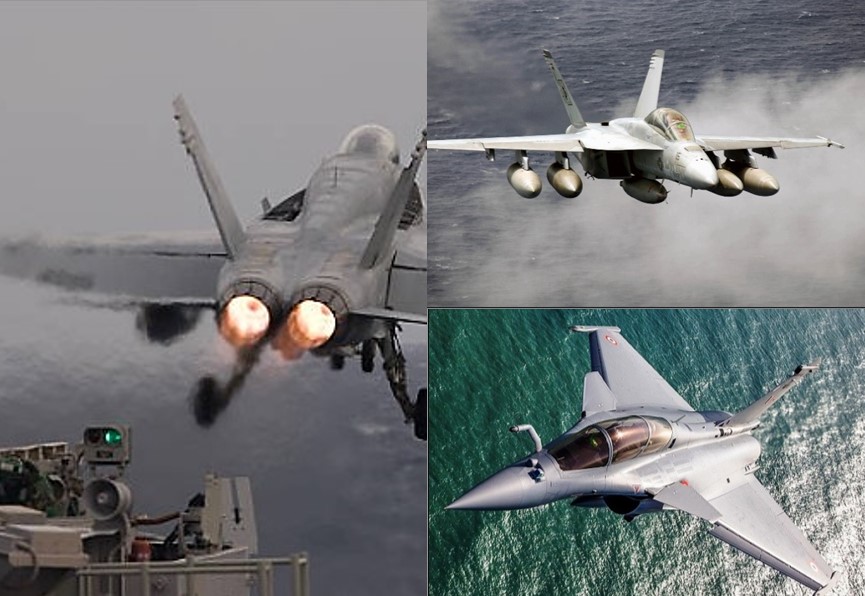
Rafale or F/A-18 ‘Super Hornet’: Who Will Board India’s Vikrant?

India’s Indigenous Aircraft Carrier (IAC)-1, christened INS Vikrant (in honour of the 50th anniversary of participation of its similarly named predecessor in the 1971 Indo-Pakistan conflict), was launched in August 2013 and completed its fourth phase of sea trials on 10 July 2022. The Aircraft Carrier (AC) looks set to meet its commissioning deadline of 15 August 2022- Government of India having pledged to commit the AC to the Nation on this year’s Independence Day!
Post commissioning, IAC-1 would still have to undergo flight-trials for its deck-based fighter, scheduled to be completed by mid-2023, before it is deemed fully operational as the second AC of the Indian Navy (IN), after INS Vikramaditya. Read more @https://chanakyaforum.com/indigenous-aircraft-carrier-indian-navys-veritable varuna/ ).
Why Did the IN Need to Look Global for a Deck-Based Fighter?
In 2017, the IN floated a RFI for procurement of 57 Multi-Role Carrier-Borne Fighters (MRCBF) to replace the current fleet of MIG-29K carrier-based fighters. Boeing’s Fighter/Attack (F/A)-18 E/F Block III Super Hornet, Dassault Aviation’s Rafale-M (Maritime), Saab’s JAS-39 ‘Sea Gripen’ and MiG Bureau’s MiG-29K responded to the RFI. The Gripen and MiG-29K were rejected- the former did not have its own powerpack and was using a version of the US General Electric F-404 Turbofan Engine, as also since Saab had provided the Saab 2000 Erieye AEW&C Systems to the Pakistan Air Force, used by them in the Balakot incident. The MiG-29K, as reflected in the CAG Report of 2016, has been riddled with safety/operational problems relating to its airframe, engine and fly-by-wire system.
In April 2020, the Aeronautical Development Agency (ADA), in collaboration with DRDO, announced work on the Twin Engine Deck Based Fighter (TEDBF). While the TEDBF was unveiled at Aero-India 2021, its maiden flight is expected by 2026, with induction to only commence in the next decade. This represents a gap of 4-5 years in modernisation of the IN’s deck-based fighter profile, which is unacceptable, given China’s burgeoning carrier fleet. China already operates two ACs and has launched its third, the 85,000 ton Type 003 Fujian, last month. China’s nuclear-propelled Type 004 AC which will carry the J-31 5th Generation fighter aircraft, is likely to be commissioned by the end of this decade.
While the present MRCBF requirement has been reduced to 26 in favour of the TEDBF, the immediate necessity was to enhance the IN’s deck-based fighter profile, prompting the IN to look towards the global market.
While avionics, versatility, firepower and Electronic Counter Measures (ECM) capability would definitely influence the choice of the MRCBF, equally important is the compatibility with the carrier platform. Since INS Vikramaditya and INS Vikrant feature the Short Take-Off But Assisted Recovery (STOBAR) Launch System, these 26 aircraft will have to be compatible with the requirement, as well as be capable of Catapult Assisted Take-Off But Arrested Recovery (CATOBAR) Launch, which will feature in the IN’s future ACs.
Why did the IN Pick the F/A-18 and the Rafale-M?
Both the Indian Air Force (IAF) and IN operate platforms from these vendors – the IAF operates Rafale and Mirage-2000 fighters manufactured by Dassault Aviation, while both Services operate platforms from Boeing- the IAF operates the C-17 Globemaster Strategic Lift Aircraft, Apache Attack Helicopters and Chinook Heavy-Lift Helicopters and the IN operates the P-8I Long-Range Maritime Patrol Aircraft (MPA).
The urgency to operationalise IAC-1 led the IN to request Boeing and Dassault Aviation to carry out shore-based ski-jump trials representing STOBAR with the Rafale-M and the F/A-18 E/F Block III at IN’s Shore Based Test Facility (STBF) at INS Hansa near Goa. The ski-jump trials were successful for both types of aircraft.

F/A-18 Carrying out Ski-Jump Trials at INS Hansa:Source-ainonline.com
How Does the Rafale-M Compare with the F/A-18 Super Hornet?
Before comparing the two aircraft, it is important to elucidate how the Rafale-M is different from the Rafale-EH (single-seater version) being operated by the IAF. The Rafale-M is 500 Kg heavier than the land-based variant due to a number of modifications. The undercarriage has been reinforced to cope with additional carrier-based landing stresses. It also features an arrestor hook, a built-in ladder and a ‘jump-strut’ nosewheel, which extends during short take-offs and CATOBAR launches. The aircraft also incorporates a carrier-based microwave landing system to assist the aircraft in landing, even in very low visibility conditions. The Rafale-M also incorporates the fin-tip mounted Telemir System for syncing the onboard inertial navigation system to external receivers.
The characteristics are enumerated below.
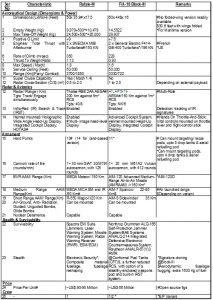
Carrier Compatibility. The F/A-18 has been extensively used by the US as a carrier-based fighter, while the Rafale-M is the only non-US fighter cleared for US AC deck-based operations. The folded-wing configuration of the F/A-18 reduces the stowage width of the aircraft to 5 feet less than the Rafale, with its rigid-wing design. This would be a major advantage in the number of aircraft that can be carried on the flight deck/hangar in IAC-1, which envisages total carriage of upto 20 fighters and 10 Anti-Submarine Warfare helicopters. Greater aircraft on the flight deck translates to faster cyclic operations. The nose-cone radome of the AN/APG-79 Radar on the F/A-18 slides forward instead of hinging sideways, saving hangar space. The additional 4000 Kg empty weight of the F/A-18 is speculated to require modifications to the elevators on board IAC-1. However, Boeing has expressed confidence that the elevators could be used in their existing configuration for lifting/lowering the aircraft to/from the flight deck. Crew strength required to be carried on board goes in favour of Rafale, being a single-seater aircraft. Both aircraft are well suited to low-speed, low-altitude manoeuvres, a facet essential for carrier-based operations.
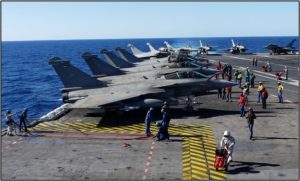
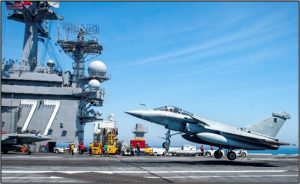
Rafale M Parked Aboard French AC Charles De Gaulle (L) & Taking Off From US AC George HW Bush (R):Source-defense.blogs.lavoixdunord.fr/Wikimedia
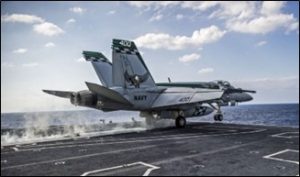
CATOBAR Launch of F/A-18 E From USS George Washington:Source-reddit.com
Aeronautical Design. The greater max take-off weight of the F/A-18 would translate into a marginally (~1000 Kg) greater fuel/armament payload. However, the ability of the F/A-18 to utilise this advantage in a STOBAR configuration needs examination. The aerodynamic CFTs on the F/A-18 would allow additional fuel carriage without increasing drag, leading to better fuel efficiency/ range enhancement. The Rafale, however, enjoys an ab-initio two-fold edge in combat range which, when combined with its supercruise capability, would allow operations from well outside surface-to-air (SAM) missile range of China and Pakistan. The superior loaded thrust-to-weight ratio of the Rafale would translate into greater power available for aerial manoeuvres. The instantaneous turn rate (ITR) of the Rafale is greater than 36º/ second, which is higher than that of the F/A-18, thus allowing the Rafale a tighter turn radius/quicker rate of turn, factors essential for success in close combat. The Rafale has greater G-Limit capability, advantageous in a dogfight/evasive manoeuvre situation. It also enjoys a superior rate of climb, which would aid in short take-off/landing (STOL) from IAC-1. The F/A-18 is likely to have better ‘nose-control’, in part because of enlarged leading edge extensions- enabling high angle-of-attack manoeuvres for missile launch and allowing quicker regaining of control by the pilot. The F/A-18 also enjoys a significant ‘bringback’ capability, wherein it can return to the AC with upto 4100 Kg of unspent fuel, thus easing the logistics burden during routine sorties.
Radar & Avionics. The Rafale’s Thales AESA Radar has greater range, target track/engage capability and horizontal tracking angle than the F/A-18’s Raytheon AESA Radar. The Thales AESA also comes with real-time 3D mapping for terrestrial navigation/targeting. The IRST of the two aircraft are comparable. However, the Rafale has a major advantage of voice-controlled cockpit commands and HOTAS, lending to lower pilot fatigue and faster manoeuvrability. The Rafale has the recently acquired Thales Scorpion Helmet Mounted Display, which allows flight data to be cued through the pilot’s field-of-view, thus enhancing situational awareness (SA). The F/A-18 is equipped with a quadruplex digital fly-by-wire system, as well as a digital flight-control system that detects and corrects for battle damage. The F/A-18 E/F Block III has been upgraded with the Joint Helmet Mounted Cueing System, which facilitates missile-cuing at large deflections from the flight axis. The Shared Reconnaissance Pod is a tactical reconnaissance system that features advanced day/night and all-weather capability. The Rafale enjoys multi-sensor data fusion capability, integrating inputs from the sensors, AESA radar and Spectra Electronic Warfare (EW) System.
Armament. The greater number of hard points on the Rafale would mean greater weapon-carrying capability. Additional hard points could also accommodate fuel drop tanks without compromising armament. The stated ranges of the long-range air-to-air missile (AAM) on both aircraft are comparable, leading to similar BVR capability, purely in terms of armament ranges. The MBDA Meteor on the Rafale is a heavier missile (~ 200 kg), when compared to the AIM-120 AMRAAM (~150 kg), which may suggest marginally lesser manoeuvrability of the former. However, the MBDA Meteor uses a Ramjet engine with a solid-fuel booster, unlike the AMRAAM’s solid-fuel motor, thus allowing adjustable burn rate and therefore optimum acceleration, depending upon the target’s speed/position. This translates to a larger ‘no-escape zone’ in favour of the Meteor. Lower target engagement capability of the F/A-18 vs Rafale (6 vs 8 targets) and lesser number of hardpoints would translate into greater ‘1 on 1’ lethality in favour of the Rafale. Greater capacity of the Vulcan autocannon on the F/A-18 might prove beneficial in a close combat situation. However, Rafale is reported to have the capability to mount a twin 30mm autocannon to augment its close-fire capabilities. The F/A-18 might also accrue an advantage of range in the short and short-medium range air-to-air missile capabilities.
Stealth & Survivability
The Rafale airframe is composed of approximately 70% composite material with radar absorbent material coating. The airframe is designed with serrated patterns along trailing wing/ canard edges, concealed turbine blades and a serpentine like air-intake. This significantly reduces the RCS of the aircraft. Among the measures adopted for the F/A-18 E/F Block III to reduce RCS/ enhance stealth, are the modified engine intakes, use of radar-opaque perforated panels to cover inlet/exhaust ducts, uniform alignment of fuselage panel boundaries/edges and filling up of radar-resonant cavities and surface joints. The Rafale is equipped with the ‘Spectra’ EW System as earlier mentioned, which provides multi-spectral long-range threat warning, detection and identification, allowing the pilot to instantly select the most effective defensive measures/evasive manoeuvres. The Spectra also allows customisation/updation of threat profile specific to the user country, thus allowing ‘tailor-made survivability’. The F/A-18 mounts the Northrop Grumman Self-Protection Jammer System/BAE Systems Integrated Defensive Electronic Countermeasures System, as well as the Raytheon AN/ALR-67(V)3 radar warning receiver. It also enjoys Multifunctional Information Distribution- an advanced jam-resistant C4I system that supports key functions like surveillance, air control and weapons engagement coordination. The Rafale and F/A-18 can also deploy towed missile decoys, capable of mimicking the aircraft profile and thus mitigating the threat from missiles with radar-seeker warheads.
Capability Ratings
Capability Ratings are as enumerated below. While the Rafale scores in most categories, suitability for operations purely with respect to tailor-made avionics and ease of handling on small to medium-sized ACs, as is the case with India, would be in favour of the F/A-18.
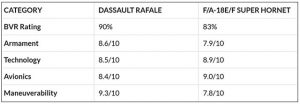
Capability ratings:Source-aviatia.net
Conclusion
While the manoeuvrability and BVR capability of the Rafale would prima facie appear to tilt the scales against the F/A-18 E/F Block III, the tailor-made carrier-based design of the F/A-18 would go in its favour. The significantly lower cost of the F/A-18 would be another major factor for consideration. Also important is the fact that while the IAF already operates the Rafale and therefore has significant operating experience on the aircraft, the F/A-18 would seamlessly integrate with the US P8I MPA acquired from the US, for prosecuting maritime operations. All in all, the IN will have to decide between the important facets of operational efficiency, ease of operation and cost of acquisition/ maintenance while choosing the contender for a carrier-based fighter aboard IAC-1.
Disclaimer
The opinions expressed in this article are the author’s own and do not reflect the views of Chanakya Forum. All information provided in this article including timeliness, completeness, accuracy, suitability or validity of information referenced therein, is the sole responsibility of the author. www.chanakyaforum.com does not assume any responsibility for the same.
Chanakya Forum is now on . Click here to join our channel (@ChanakyaForum) and stay updated with the latest headlines and articles.
Important
We work round the clock to bring you the finest articles and updates from around the world. There is a team that works tirelessly to ensure that you have a seamless reading experience. But all this costs money. Please support us so that we keep doing what we do best. Happy Reading
Support Us





















POST COMMENTS (0)